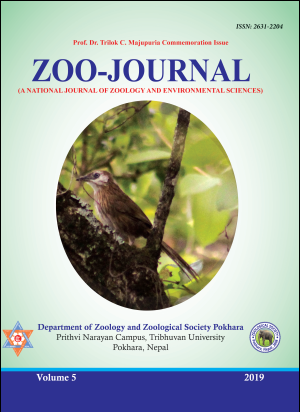Induced Spawning of Sahar, Tor putitora (Hamilton-Buchanan) in Terai Region of Nepal
DOI:
https://doi.org/10.3126/zooj.v5i0.34775Keywords:
Tor putitora, spawning behaviour, artificial propagationAbstract
Sahar, Tor putitora (Hamilton-Buchanan) is a high valued indigenous riverine species of Nepal. This is declining in its natural habitat. Tor putitora and Tor tor (Hamilton-Buchanan) have been recommended as vulnerable and endangered species. Limited seed production using natural propagation has restricted its expansion in culture as well as rehabilitation in natural waters. The artificial propagation of sahar using synthetic hormone was conducted in Pokhara, AFU, Chitwan and CARP), Kathar during February to April 2017. Sixty five male (0.5-1.8 kg) and forty five female (1.1-2.1 kg) brood fish were reared in 200 m2 earthen ponds at 1000 kg/ha. Fish were fed with 32% crude protein feed at 3% body weight per day. Maturity was observed regularly for softness of the abdomen. Female brood fish with a soft and extended abdomen were injected with synthetic hormone (Ovaprim) at 0.5 ml/kg body weight. Males were not injected hormone. The fertilized eggs were incubated in Atkin hatching trays. A total of 16 females were induced to spawn, and they produced 1630.80±184.30 (mean±SE) eggs per kg body weight. Mean hatching and larval survival rates were 78.4±1.9 and 74.7±1.1%, respectively.
Downloads
Downloads
Published
How to Cite
Issue
Section
License
© Department of Zoology and Zoological Society Pokhara, Nepal

